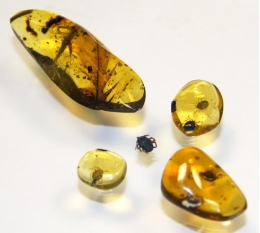Researchers find the first tick that feed from dinosaur blood a hundred million years ago
The new study is based on Burmese amber pieces from the Cretaceous which show an open window to visit the world of feathered dinosaurs. In the study, experts analyse a Burmese amber piece from the Cretaceous which had a fossil tick –a model of Cornupalpatum burmanicum, an extinguished species- stuck to the feather of a theropod dinosaur.
“This finding is important because it is hard to find fossils of blood-feeding parasites directly related to the remains of their host. Also, this model of hematophagic parasite is the oldest one known so far in the parasitism between arthropods and vertebrates” says Xavier Delclòs (UB-IRBio). The article is also signed by Enrique Peñalver (Geological and Mining Institute of Spain, IGME); Ricardo Pérez de la Fuente (University of Oxford, United Kingdom), David Grimaldi (American Museum of Natural History, United States), Antonio Arillo (Complutense University of Madrid) and David Peris (Jaume I University, UJI), among other experts.
According to Enrique Peñalver (IGME), main author of the study, “ticks are blood-sucking parasites, and can affect the health of humans, livestock, pets, and wild animals. However, there was not scientific evidence on their role over evolution so far”. The short life of yje complex DNA molecule, made the recovery of dinosaurs’ genetic material impossible, a sophisticated technique that inspired successful movies to take back the main characters of the Secondary Era on Earth.
